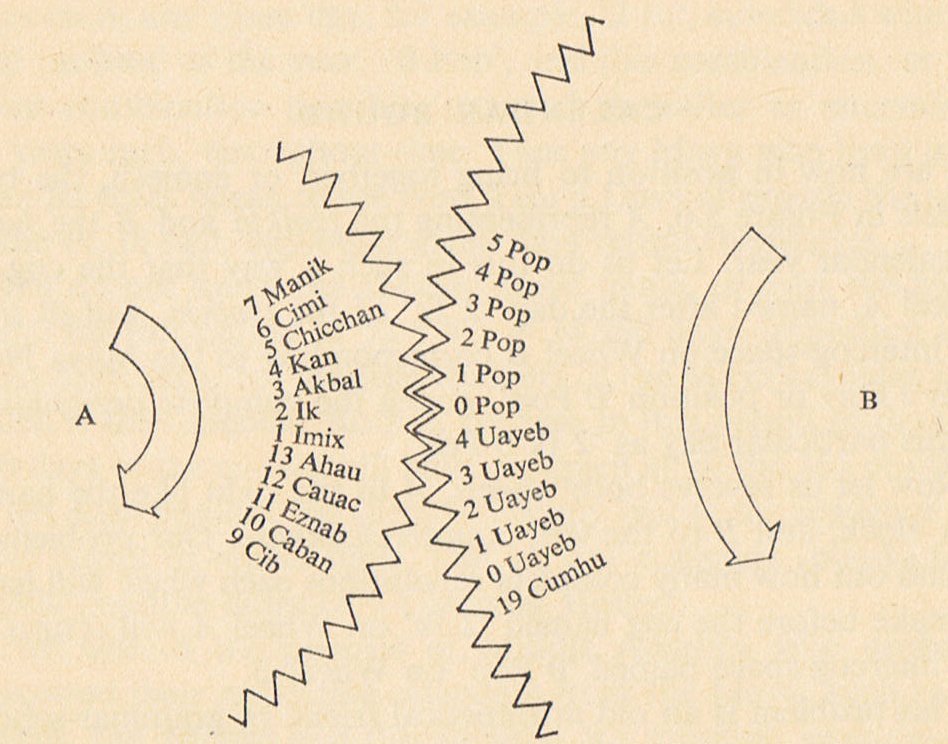|
TRANSLATIONS
The 3rd mauga has a growing moon sign which makes me think there is more to the story than a simple mark of ⅔:
There are 20 glyphs in period 1, and in a way it belongs to the previous year. 124 - 20 = 104 = 4 * 26, and there are 26 glyphs beyond Eb5-11 to reach the end. I.e., the 3rd mauga is located as glyph number 8 * 13 = 104 into the calendar counted from the beginning of the 2nd period:
130 was also the number of what I earlier named 'the main body of the calendar' = from period 1 up to and including period 20. Consequently, there are 20 glyphs not only in the 1st period but also from the 1st glyph in the 21st period up to Eb6-2:
What happens in those 5 nights before Eb5-18?
We have to wait until later to answer some of our questions. Instead, I have decided to try to document in a more systematic way at least some of the results arrived at in this investigation into the mysteries of the 3 mauga glyphs. Therefore I have rewritten the summary page in the glyph dictionary:
The 'excursion' is not needed in order to understand the fundamental meaning of mauga glyphs. On the other hand the glyph dictionary ought to give realistic examples of how to use the fundamental meanings described. The methods used in interpreting rongorongo texts cannot be described in any other way than by showing examples. There is also a need to clarify how the calendars are constructed. The Keiti calendar for the year is not easily understood. It is not just a simple 24 half-month sequence of periods, yet in a way it is can be used so. On the other hand, the Maya Indians had a year (haab) with 19 months (18 with 20 days - 360 days - followed by a last month with only 5 days). The Keiti calendar can be read as having 18 periods (from the beginning of the 2nd period up to and including the 3rd mauga period), followed by 5 extra days. The Mayas furthermore used 13 and 260, numbers we can recognize (e.g. as 26 * 2 in the K calendar summer season). "... The ancient Maya, man or woman, regarded his or her birthday not as the position in the tropical year, that is the month-day, upon which he was born, as we do, but the day of the tzolkin, or 260-day sacred year upon which he was born. The god of the particular day of this 260-day period upon which a man was born was his patron saint, his guardian deity, his celestial godfather, so to speak ... ... The 260 days of the sacred year were formed by pre-fixing the numbers 1 to 13 inclusive to the twenty Maya day-glyphs, the names of which are given below, beginning with Ik, one of the Old Empire year bearers ...
... The Maya calendar year, or haab, was composed of 19 months - 18 months of 20 days each, and 1 closing month of 5 days, making a total of 365 month-positions in the calendar year. These 19 divisions are given below ...
In order to show clearly how the 260 days of the tzolkin were combined with the 365 positions of the haab or calendar year, let us represent them graphically as two cogwheels ...
The Mayan zero is a picture of a shell - presumably an empty one. Tagaroa alone in his shell takes on a new meaning, the shell signifies the beginning, there is nothing. Beyond the 5 glyphs between 50 and 20, in the 21st period (or 20th if we begin with the 2nd period), there is a shell:
At least, that is what Metoro appears to say: mama mamae hia. The obvious wordplay is somewhat enigmatic:
A zero is like an open empty sea-shell. The meaning of mama basically seems to be 'open', like a mouth or limpet. From this will easily be derived a meaning of open = not determined (as in the beginning of all things). There is no structure yet. As soon as there is a structure there no longer is a mess (what children are fed). A mama is like the ... 'congregation hall' ... in which a special room (Schicksalskammer, Ubugina) was assigned for the future ...' Cfr mama-orero (the next phase) when the council has decided. An empty shell has practically no weight, another of the meanings of mama. A house for spirits, a pure. But there is an example of pure in the Keiti text, and there must be some difference in meaning:
In Eb1-19 (the darkest time for the sun) a new fire is alighted. Two glyphs later (Eb1-21) the fish (of the sun) is rising again. In Eb1-31 an old fish is still living, held by a 'ghost'. Eb1-34 is surrounded by 'ghosts' (glyphs where the border line is open). The glyphs at the beginning of the 1st period (Eb1-37 etc) are also a 'ghosts'. Notably the pure glyph (Eb1-34) is not drawn as a 'ghost'. Indeed, no pure glyph anywhere appears to be drawn otherwise than as a concrete object. If we count, we will find Eb5-19 to be located 8 glyphs beyond 104 (at the 'moon' mauga):
112 = 4 * 28, and there are 18 glyphs remaining to the end (Eb6-2). Yet 19 is the ordinal number in line b5. The visual cues, I imagine, is 'zero' for the sun at Eb5-18 (with 18 alluding to a full cycle), followed by a dark empty shell also - I guess - indicating 'zero'. No 'ghost' visible, though. Beyond the 21st period (the full cycle period) signs of new 'fire' arrive (cfr Eb5-21), while the 'kiore' show signs of being 'ghosts'. A new season is generated by the great 'moa' (Eb5-22):
|
|||||||||||||||||||||||||||||||||||||||||||||||||||||||||||||||||||||||||||||||||||||||||||||||||||||||||||||||||||||||||||||||||||||||||||||||||||||||||||||||||||||||||||||||||||||||||||||||||||||||||||||||||||||||||||||||||||||||||||||||||||||||||||||||||||||||













